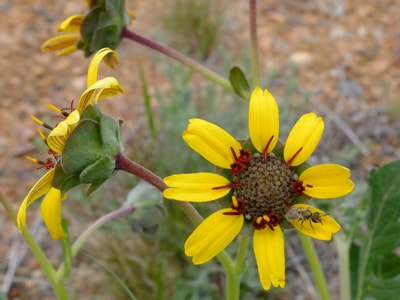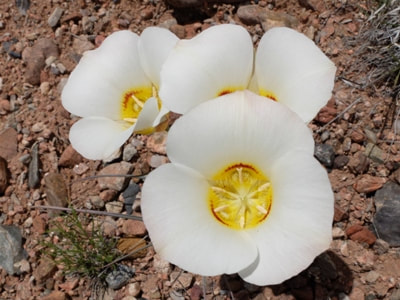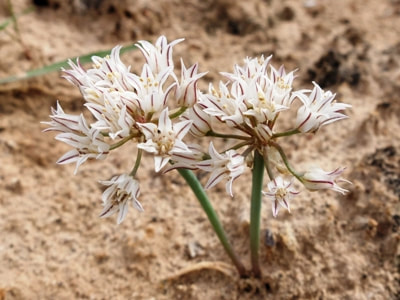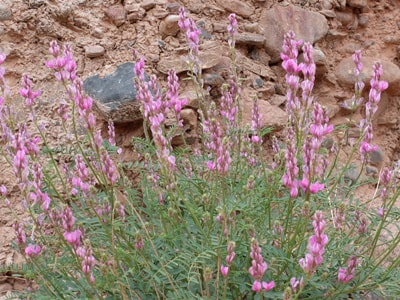|
Found in dry areas, roadsides, grassy slopes
Seen blooming in May at Abiquiu Lake The roadsides up at the Lake were bright with masses of Chocolate Flowers and Perky Sue until the USACE mower came along, but some can still be seen that were out of the mower’s reach and the others should come back. They grow to two feet tall, erect or leaning, with lobed, toothed leaves that are lyre-shaped. Flowers are bright yellow with a maroon disk of stamens that smell like unsweetened chocolate. The petals have red veins underneath, the bracts below the petals are large and petal like. They open in the morning and droop in the heat of the day. Native Americans used the Chocolate Flower to alleviate stomach problems. There are claims that the smoke from dried, burned roots will calm a nervous condition and in some cultures, inspire courage. Source. If you are trying to identify a different flower then you can check what other flowers bloom this month. If you cannot identify a flower from the website send a photo and where you took it to [email protected]. Read online for tips.
0 Comments
Found in dry meadows, slopes, sagebrush
Seen blooming in May in Red Wash Canyon Thanks to the moisture this year there is a profusion of these beautiful, exotic-looking lilies in bloom in the canyon. Its scientific name means “beautiful herb”. It grows 6 to 18 inches tall with one to four flowers. Leaves are narrow and folded, grass-like. The flowers are 2 inches across and tulip-like with white petals tinged with lilac and a bright yellow base. Inside the flower there is a purple/maroon band around a fringe of yellow hairs and anthers. Sego Lily has been used as dried food, candy and as food for winter by Native Americans who introduced it to the Mormons which kept them alive and thus it became the Utah state flower. The bulbs were dried and preserved for winter use, eaten raw, roasted, peeled and then eaten, and the flower was used ceremonially. Source. If you're trying to identify a different flower, then you can check what other flowers bloom this month. If you cannot identify a flower from the website send a photo and where you took it to [email protected]. Read online for tips. Found in dry, sandy, rocky areas
Seen blooming in May in Plaza Blanca There is an abundance of wildflowers in bloom at the moment and it was difficult to decide which to showcase this week. There are masses of bright orange globemallows and bright yellow four-nerved daisies since the recent rains so I chose a less showy but interesting plant, also abundant but easily overlooked. This onion grows to 8 inches high in colonies from bulbs buried up to 6 inches deep. Leaves are slender and grass-like and extend beyond the flower stems. Bell-shaped flowers grow in rounded clusters about 1 inch across. The flowers are about ½ inch long and have 6 white or pinkish petals with a reddish-purplish stripe. The wild onions are in the same family as garlic, shallots, leeks and chives. Leaves, flowers, and bulbs can be eaten fresh, the bulbs cooked with other food, or stored for winter use. Juice of the plant is used as a moth repellent. The whole plant will repel many insects and is said to deter moles. The onion has a long tradition of medicinal uses for a wide variety of conditions covering everything from teething babies to snakebite cures. Source. If you are trying to identify a different flower then you can check what other flowers bloom this month. If you cannot identify a flower from the website send a photo and where you took it to [email protected]. Read online for tips. Found in sandy, rocky soil
Seen blooming in May on CR 142 When in bloom the Pale Wolfberry is an attractive shrub growing to 6 feet tall with many branches. Leaves are pale gray-green and smooth edged, and have slender thorns at the base. Flowers are funnel-shaped, greenish-white with purple veins and are over 1 inch long. The fruit is orange-red like a small tomato and can be reddish-blue. The fruit can be eaten raw if perfectly ripe, or cooked or dried for later use. The fruit keeps well when dried and ground into a meal. The ground up root has been placed in a tooth cavity to bring relief from toothache. The bark and the dried berries have been used as a 'life medicine'. The fruit of many members of this genus is a very rich source of vitamins and minerals, especially in vitamins A, C and E, flavanoids and other bio-active compounds. It is also a fairly good source of essential fatty acids, which is fairly unusual for a fruit. It is being investigated as a food that is capable of halting or reversing the growth of cancers. Source. If you are trying to identify a different flower then you can check what other flowers bloom this month. If you cannot identify a flower from the website send a photo and where you took it to [email protected]. Read online for tips. Found in canyons
Seen blooming in May in Red Wash Canyon Sweetvetch grows bushy to two feet tall with leaves divided into pale green leaflets. The flowers are pink to pink-purple. The seedpods are segmented between each seed giving the appearance of links in a chain. Young tender roots have a sweet carrot or licorice-like flavor and can be eaten raw or boiled, baked or added to soups. Source. If you trying to identify a different flower then you can check what other flowers bloom this month. If you cannot identify a flower from the website send a photo and where you took it to [email protected]. Read online for tips. |
AuthorI am Marilyn Phillips, a native of England, whose love of nature and the outdoors from childhood brought me by a circuitous route to Crested Butte, Colorado in 1993 and 16 years later to northern New Mexico. My exploration of the many trails in these areas, my interest in wildflowers and photography, and career in computer system design came together in this creation. If you have any corrections, comments or questions, please contact me by email. Archives
September 2025
Categoriescopyright © 2020
|







 RSS Feed
RSS Feed